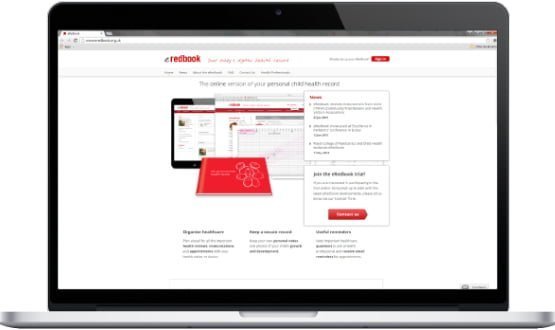The little red (e)book

Although I haven’t had cause to consult it for several years, I can still reach out and pick up my daughter’s ‘red book’ from a shelf next to my desk.
Given to me at her birth nearly 16 years ago, this is her personal health record, and contains weight charts, growth charts, details of vaccinations given, and records of developmental milestones.
A PHR on paper
The red book has been around nationally for 25 years. Unlike other health records, it includes information recorded both by health professionals and by parents and guardians.
At a time when most GPs and hospitals are using electronic patient records (for at least some of their services), the paper red book has resisted digitisation. But all that is about to change.
A project is underway to digitise the red book, making it available to parents as a secure electronic record that they can access from their smartphone, tablet or PC.
It will still be owned by parents and carers, but once they have signed in, they will be able to “hand” the record over to a health visitor to enter data, just as they do with the print version – although they will be able to continue with the print version if they prefer.
So why get rid of a system that has worked well for many years? David Low, chair of the informatics quality committee at the Royal College of Paediatrics and Child Health, which is backing the project, says that the print record is not much used after the age of three or four.
This is particularly because GPs often regard it as a health visitor tool. An easily accessible electronic version could change this.
In addition, Low points out, a paper record relies on parents remembering to carry it. “If your child is rather desperately ill and rushing off to A&E the last thing you do is rummage in the bottom drawer to try and find the red book.”
Developed and piloted
Last year’s ‘Personalised Health and Care 2020’ report, which set out the government’s plans to increase the use of information technology in the NHS, endorses the principle. “For parents of newborns, we will encourage digitisation of the personal child health record (the ‘red book’).”
The digital record – known as eRedbook – has been developed over the past three years by Sitekit Apps, in conjunction with Harlow Printing, which makes the paper copy. A secure log-in is provided through Microsoft HealthVault.
Initial pilots have been carried out by Liverpool Community Health NHS Trust and South Warwickshire NHS Foundation Trust.
Blackpool Teaching Hospitals NHS Foundation Trust joined late last year; but the trust is waiting to hear if it will receive funding from the second tech fund – or ‘Integrated Digital Care Fund’ – before it begins recruiting parents.
South Warwickshire is still considering the options for adopting the eRedbook post the pilot phase.
Designed with users, scope for local input
To make sure that the record is as user-friendly as possible, it has been developed in conjunction with users (both health professionals and parents) in Liverpool and South Warwickshire.
It has been designed to have the same look-and-feel as a social media application, such as Facebook.
Both parents and health visitors can enter data such as weight, and the information is colour-coded to show who entered it. Parents can personalise the eRedbook by adding photographs to illustrate particular developmental stages, and there are plans to let them share elements of the record (such as growth charts and milestones) with family members.
There is scope to develop the eRedbook further, however. Daniel Moulin, director of Sitekit, says that trusts will be able to tailor it to include local content, such as information about immunisation or local mother-and-baby groups.
That information can be personalised to be relevant to that particular child’s circumstances, such as their age.
Philip Graham, health informatics programme director at Blackpool, finds the localisation element particularly attractive.
“Say an Ebola inoculation came out, we could have a campaign for that [through the eRedbook]. If a parent has got the eRedbook, we hope that we could automatically say, ‘Please come and have the inoculation next week or book an appointment’.”
Different versions of the record could be developed for children with specific conditions, such as cystic fibrosis or congenital heart disease, adds Low, so that as well as the core information common to all eRedbooks, there would be additional online pages for those conditions.
Liverpool shows it works
In Liverpool, about 500 families have signed up for the eRedbook. Parents are introduced to the idea at an antenatal appointment, to give them time to decide whether they are interested.
Jane Banks, year zero lead at Liverpool, says that it offers numerous advantages for parents. “It's about having the information with them – it's always available online for them, whereas often they do forget their red book.
“It's legible, it can't be damaged – we see a lot of paper red books that are kept in the babies' bag, and bottles leak, so they get damaged quite easily.”
Danielle Gillett, a Liverpool parent who used the paper red book with her first child, opted for the eRedbook for her second baby, Isaac, now 11 months old.
She has been very happy with the change. “It's easy to access whenever you need it, especially when someone asks you a question.
“It's dead easy to go on your phone and say ‘Last time he was weighed he weighed this, or the last immunisation was then, and he's due another one – there are links to when things are due, so that's really handy.”
Gillett has also uploaded pictures of particular milestones, such as when Isaac started crawling or started laughing. She says that it’s “really easy to do – it’s a quick click of a button.”
Now for a national roll-out?
The eRedbook needs to be more than a convenient way for parents to keep their child’s information in one place, however.
The real benefits, in terms of both efficiency and patient safety, will be felt when it is possible to integrate it with other systems.
Currently, when a health professional enters data into the eRedbook, they have to re-enter it into the relevant clinical system – just as with the print version.
Sitekit is now looking at ways of integrating with national screening, GPs, maternity, and child health information systems. “When we really start to flow information and join the records up, that's when it's going to be really exciting,” says Banks.
So can we now expect to see the project rolled out to other trusts? Information governance, which could have been an obstacle, may have been addressed by the 2013 Caldicott Review, which recommended that information should be shared across health and social care when it is in the patients’ best interests.
It’s a recommendation that should help to smooth the path for England-wide adoption of the eRedbook.
Encouragingly, Andy Williams, chief executive of the Health and Social Care Information Centre, has said that the eRedbook will be introduced in 2016 – but there has not yet been a clear commitment to funding it.
If the government is to fulfil its commitment to making the NHS a “digital pioneer”, then digitisation of the child healthcare record must surely be a priority.




